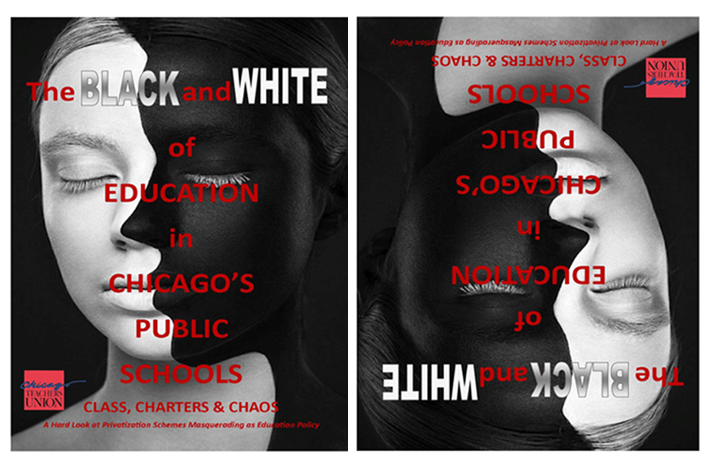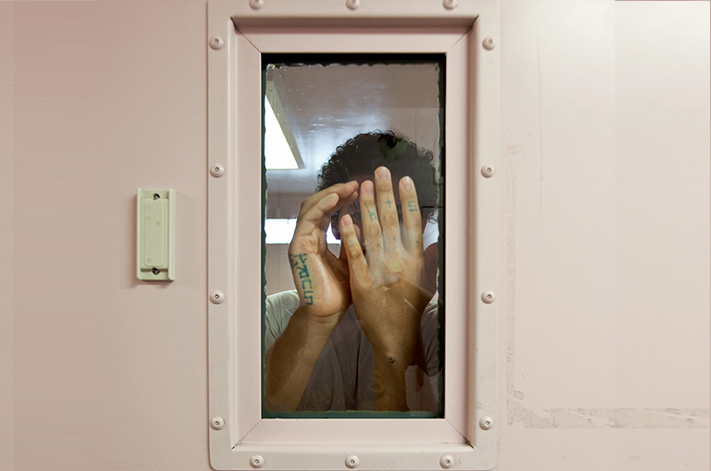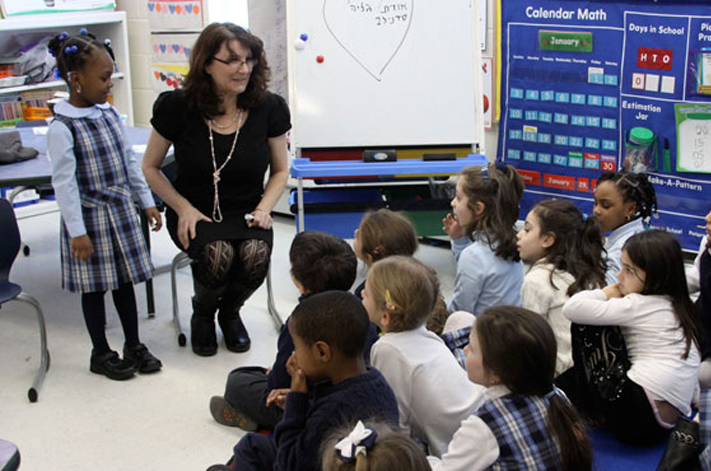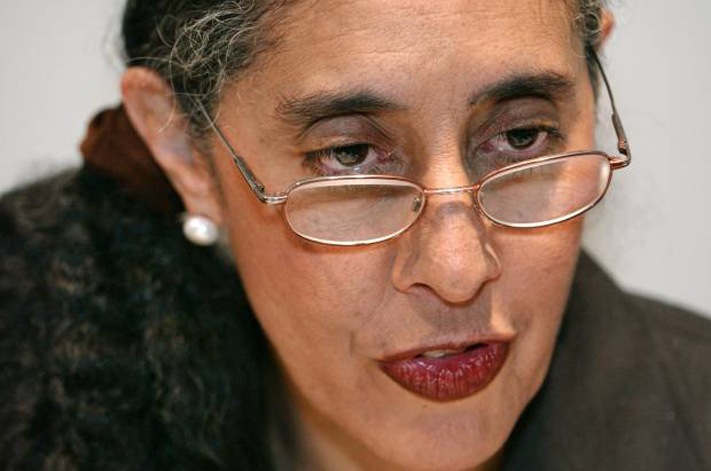Project Description

'In a new report being issued today, the Chicago Teachers Union in unambiguous terms makes a racial claim, contending that white businessmen and charter operators are gaining from what it calls 'the chaos of (public) school closings' and 'the dishonesty of underutilization.'
Executive Summary: The Black and White of Education in Chicago s Public Schools: Class, Charters & Chaos
A hard look at privatization schemes masquerading as education policy
In The Black and White of Education in Chicago’s Public Schools, the Chicago Teachers Union exposes the falsehoods and inequities created by an education policy that, rather than being held publicly accountable, is controlled by the profit-minded corporate community. As the paper proves, this debilitating policy of closing neighborhood schools and replacing them with privately-run institutions is a misguided, ineffective way to improve educational outcomes for Chicago s children.
Here are some of the negative outcomes and inequitable conditions of the Chicago Public Schools (CPS) privatization policy:
Educational Apartheid: 88 percent of students affected by CPS School Actions since 2001 are African- American. Schools more than 99 percent students of color (Apartheid schools) have been the primary target of CPS school actions representing more than 80 percent of all affected schools. These students face a wide range of challenges outside of school, including high levels of violence and trauma, but are still expected to serve as test subjects for unproven school reform schemes. The massive school closings that have been part of CPS broader strategy dating back to the 1990s have drastic consequences: they tear apart school communities, disrupt deep and strong relationships between students, parents, and teachers, and dismantle organizations which are often students only centers of stability and safety.
Actions Aimed at High Schools: Low scores on the Explore assessment, which is taken at the beginning of students freshman year, have a strong correlation with the likelihood of school actions. Despite having absolutely no control over these scores, nine of the 10 high schools with the lowest Explore scores from 2009 to 2012 have been the target of school actions. More than 90 percent of students in these schools are eligible for Free or Reduced Lunch (FRL), and eight schools are more than 95 percent African-American. Rather than closing schools, CPS needs to implement proven, research-based reforms.
The Dishonesty of Underutilization: CPS claims about school capacity has varied significantly from year to year, increasing from 65,000 extra seats in 2011 to 100,000 in 2012 alone. To the extent excess capacity exists, the main driver is the District s aggressive charter proliferation campaign. It is dishonest for the District to talk about underutilization when it has inhabited, acquired or constructed space to educate almost 50,000 additional students in the last ten years and has plans to open another 60 charter schools over the next several years. Further, underutilization numbers perpetuate the trend of CPS schools continuing to have the highest class sizes in Illinois. Simply put, closing schools means less available classrooms and more students are crowded into the classrooms that remain.
Misguided Attempts to Reduce the Budget: Despite the District s assertion that spending must be reduced, annual CPS spending for charter schools increased by 624 percent between fiscal years 2004 and 2012. Closing neighborhood schools does not save significant money. Even if the District closed 100 schools, annual savings of $50-$80 million constitute only 1-1.5 percent of the District s operating budget. Further, those savings do not reflect increased costs for transporting students, emergency response costs associated with increased violence or the costs of fracturing a school community. These counterintuitive policies have only harmed students not increased fiscal capacity.
The Chaos of School Closings and the Portfolio District: Charter proliferation and portfolio management policies destabilize the District with no systematic educational benefits to students in sight. At the core of the portfolio strategy is a belief that if competitive business principles including organizational destruction are applied to schools, then educational outcomes will radically improve. Portfolio policies specifically target sanctions instead of support to the bottom 5 percent of schools. Charter operators, such as ACT, KIPP-Ascend and Urban Prep, have repeatedly caused disruption by closing their doors and moving locations, while still convincing CPS to spend at least $18.6 million rehabbing buildings that the original neighborhoods students could no longer use. As parents and community leaders have argued, closing neighborhood schools risks losing dedicated teachers and increases safety concerns.
The Educational Failure of Charter Schools: One of the biggest myths about charter schools is that as a whole, they outperform CPS neighborhood schools. However, in addition to insignificant average differences, certain populations of CPS students have better outcomes when they attend neighborhood schools instead of those run by charter operators. Charters have performed worse even in high-need areas. Among elementary schools with a 90 percent student population that qualifies for a FRL and are at least 90 percent black, charters average at the 33rd percentile in reading test score gains. Their neighborhood school counterparts score at the 43rd percentile, outranking charters by 10 percentile points on reading test score gains. CPS magnet elementary schools also significantly outperform comparable charters on CPS accountability measures. On average, non-selective magnet schools outrank charters by 12 percentile points in reading and two percentile points in math.
Test Prep Network: The Noble Network has a laser-like focus on ACT scores despite a lack of predictive validity for college success. Freshmen and sophomores take quarterly Hedgehog exams (written by teachers) that utilize ACT style questions and power standards. Juniors are required to take a collegiate seminar twice a week after school that is really just an intensive ACT prep course. Since pay is linked to test scores, Noble teachers are forced to spend a large portion on test prep. According to a Noble teacher, There is a lot of individual pressure by the teachers since it s tied to pay, which I think makes a significant difference in the mentality for the teachers. I must teach these kids how to do X, Y and Z or else I won t get my bonus. It s a much more corporate style atmosphere in general. Instead of actual teaching, students are drilled to prepare for test questions.
Teacher Diversity and Churn: In CPS, the percentage of students of color far exceeds the percentage of teachers of color across CPS. However, this diversity gap is especially prominent at charter schools. At charters, more than 95 percent of students were black or Latino/a, while only a combined 30 percent of teachers identified as either black or Latino/a, resulting in a diversity gap of 65 percent across charter schools. The UNO Charter Network has a student population that is 95 percent Hispanic but only 11.6 percent of its teachers identify as Hispanic or Latino/a. The Noble Street Network is composed of 95 percent students of color, but only 19 percent of their teachers identified as black or Latino/a. Annual staff overhaul is a systemic feature of charters. While age and experience certainly play a role in teacher turnover, charter school teacher attrition cannot be explained just by the fact that their teachers are younger and less experienced. While 67 percent of CPS first year elementary teachers returned to their school, only 54 percent of all teachers returned to their UNO campuses. A similar retention gap exists in high schools, with 75 percent of first year CPS high school teachers returning but, for example, only 65 percent of all teachers at Noble. This large turnover in charters influences teacher experience charter teachers average about four years of experience, compared to 14 years for CPS teachers.
Reclaiming Real Innovation in Neighborhood Schools: In 2010, Bill Gates said, Charter schools are especially important right now because they are the only schools that have the full opportunity to innovate. Charter innovation has not produced broad achievement gains, and what we do know about their practices indicates that rapid charter proliferation has compounded and amplified the most egregious forms of educational apartheid found in CPS. The supposed bureaucracy that holds back innovation in neighborhood schools is not an inherent feature of public neighborhood schools but an intentional policy of disinvestment that withholds resources for innovation in neighborhood schools and gives additional funding and autonomy for charters. There are many innovative approaches that neighborhood schools can use to improve instruction and learning through collaboration and professional development. The Children s Literacy Initiative (CLI) focuses on building capacity for ongoing professional development for K-3 teachers and reducing class sizes. Lesson Study, which focuses on teacher collaboration, is another innovation that warrants expansion. The Responsive Classroom format aims to develop social skills of cooperation, responsibility, and empathy in concert with the acquisition of deep subject knowledge, decision making and motivation for learning. These are just a few proven alternatives to the regime of test-based accountability. They can replace our rigorous but meaningless standardized testing practices with assessment systems built on challenging, subject-specific tasks, a wide array of demonstrated knowledge, extensive documentation and active learning.
CPS must end the failed policy of closing or otherwise acting against neighborhood schools and replacing them with charter schools. Instead, CPS should provide neighborhood schools with the resources needed to give students and parents the schools they deserve.










